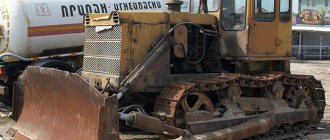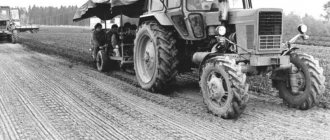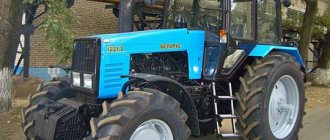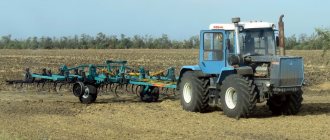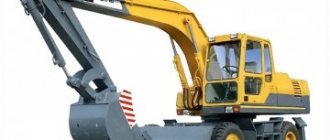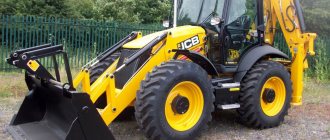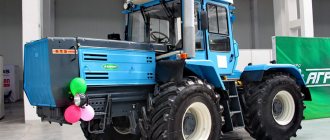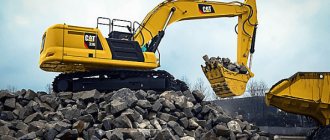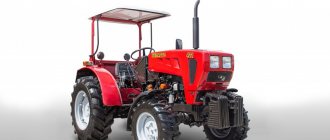Category: ENGINE
- Description of the ZIL 130 engine
- Engine ZIL 130 technical characteristics
- Engine ZIL 130 - device
- Tuning the ZIL 130 engine
In the fate of the oldest automobile plant in Russia (founded in 1916), named in honor of Ivan Alekseevich Likhachev, the main role was played by two products of the same name, the car and the ZIL 130 engine. Both units became the personification of the enterprise, long securing its reputation as a manufacturer of reliable, durable and not “ killed" cars and power plants.
Production began in 1964. The engine for the car was created using the ZIL-111 traction unit as a basis, making many changes to the design. The resulting product is known to every resident of our region, since at the end of the production period over 3,000,000 copies of the “one hundred and thirty” were running on the roads. For that time, both the car and the engine were an example of quality and unpretentiousness. The indicators influenced the popularity of the product, making it in demand and indispensable among trucks.
Engine ZIL-130:
Technical characteristics of T-130, weight
The weight of the T-130 bulldozer was just over 12 tons. The basic version was characterized by a specific ground pressure of 0.05 MPa.
| Structural weight | 12,720 kg |
| Traction class | 10 |
| Engine power | 140-160 hp (depending on model) |
| Specific ground pressure | 0.05 MPa |
| Hydraulic system | 100 l |
Diesel engines D130 VMTZ in Novosibirsk (Car engines)
They are used to complete tractors, self-propelled chassis, small loaders, compressor stations, welding units, and power plants.
Diesel engine D130 General description of the diesel engine D130 The D130 engine is a powerful four-stroke diesel engine. The main difference between an engine that runs on diesel fuel and an engine that runs on gasoline is the different methods of supplying the air-fuel mixture to the cylinder and the method of its ignition. The operating principle of the D130 diesel engine uses a thermodynamic cycle with an isochoric-isobaric heat supply. The high level of compression increases the efficiency up to 50% compared to a gasoline unit. The principle of operation of the D130 four-stroke engine is a sequential change of operations. During the first stroke, fresh air is drawn into the cylinder through the open intake valve. During the second stroke of operation, the intake and exhaust valves are closed, and the air is compressed in volume by approximately 17 times, as a result of which the air becomes very hot. Before the start of the third stroke (power stroke), fuel is injected into the combustion chamber through the injector nozzle. When injecting fuel, it is sprayed into small particles, which are evenly mixed with compressed air, during which a self-igniting mixture is created. When fuel burns, energy is released, and the piston of the D130 engine begins to move in the power stroke. Fuel injection continues and causes the combustion of fuel to maintain constant pressure on the piston. During the fourth stroke, the exhaust valve opens and exhaust gases pass through the exhaust valve. In comparison with the D120 engine, the technical characteristics of the D130 engine are significantly improved. The operating power of the D130 engine reaches 45 hp, and the rated power is 40 hp. The engine cylinders are arranged in three rows, vertically, their displacement is 3.12 liters. Air is supplied to the cylinder separately from the fuel and is then compressed. Due to the high degree of compression, when the air is heated to the auto-ignition temperature of diesel fuel 800 - 900 C, it is injected into the combustion chambers by nozzles under high pressure. The specific fuel consumption at rated power of the D130 is 236 g/kWh, and at operational power it is 241 g/kWh. The technical characteristics of the D130 have been significantly improved compared to its predecessor, the D120. The operating power of the D130 engine reaches 45 hp, and the rated power is 40 hp. The engine cylinders are arranged in three rows, vertically, their displacement is 3.12 liters. Air is supplied to the cylinder separately from the fuel and is then compressed. Due to the high degree of compression, when the air is heated to the auto-ignition temperature of diesel fuel 800-900 C, it is injected into the combustion chambers by nozzles under high pressure. Specific fuel consumption at rated power D130 is 236 g/kWh, and at operating power – 241 g/kWh. Main technical characteristics of the D130 diesel engine
Catalog - diesel enginesDiesel engine D120Diesel engine D130Diesel engine D144Diesel engine D130TDDiesel engine D145T
bizorg.su
Dimensions
The overall dimensions of the tractor in question were 5.2 m (length), 2.5 m (width) and 3 m (height).
| Length | 5 193 mm |
| Width | 2,475 mm |
| Height | 3,085 mm |
| Ground clearance | 415 mm |
| Base | 2,478 mm |
| Track | 1,880 mm |
Engine T-130
The first samples produced at the Chelyabinsk Tractor Plant were equipped with a 140-horsepower D-130 engine. Since the mid-70s, bulldozers began to be equipped with more powerful D-160 diesel engines, producing up to 160 hp.
Photo source: techstory.ru Later models of T-130 bulldozers were equipped with a D-160 engine
The standard fuel consumption of the bulldozer was 244.3 g/kW*h. The car was equipped with a fuel tank holding 290 liters.
Type of diesel engine D-130: four-cylinder, four-stroke with a combustion chamber in the piston bottom. To start the diesel engine, an auxiliary carburetor motor with an electric starter was used. For the starting engine, a mixture of gasoline and motor oil was used.
| Engine make | D-130 |
| Cylinder diameter | 145 mm |
| Piston stroke | 205 mm |
| Specific fuel consumption | 244.3 g/kWh |
| Fuel tank | 290 l |
| Engine lubrication system | 32 l |
| Cooling system | 60 l |
se33
The entire catalog is VMTZ diesel engines
General description of diesel engine D 130
The D 130 engine is a powerful four-stroke diesel engine. The main difference between an engine that runs on diesel fuel and an engine that runs on gasoline is the different methods of supplying the air-fuel mixture to the cylinder and the method of its ignition. The operating principle of the D130 diesel engine uses a thermodynamic cycle with an isochoric-isobaric heat supply. The high level of compression increases the efficiency up to 50% compared to a gasoline unit.
The operating principle of the D 130 four-stroke engine consists of a sequential change of operations. During the first stroke, fresh air is drawn into the cylinder through the open intake valve. During the second stroke of operation, the intake and exhaust valves are closed, and the air is compressed in volume by approximately 17 times, as a result of which the air becomes very hot. Before the start of the third stroke (power stroke), fuel is injected into the combustion chamber through the injector nozzle. When injecting fuel, it is sprayed into small particles, which are evenly mixed with compressed air, during which a self-igniting mixture is created. When fuel burns, energy is released, and the piston of the D130 engine begins to move in the power stroke. Fuel injection continues and causes the combustion of fuel to maintain constant pressure on the piston. On the fourth stroke, the exhaust valve opens and exhaust gases pass through the exhaust valve.
In comparison with the D 120 engine, the technical characteristics of the D 130 engine have been significantly improved. The operating power of the D130 engine reaches 45 hp, and the rated power is 40 hp. The engine cylinders are arranged in three rows, vertically, their displacement is 3.12 liters. Air is supplied to the cylinder separately from the fuel and is then compressed. Due to the high degree of compression, when the air is heated to the auto-ignition temperature of diesel fuel 800 - 900 C, it is injected into the combustion chambers by injectors under high pressure. Specific fuel consumption at rated power D 130 is 236 g/kWh, and at operating power – 241 g/kWh.
The technical characteristics of the D 130 have been significantly improved compared to its predecessor, the D 120. The operating power of the D 130 engine reaches 45 hp, and the rated power is 40 hp. The engine cylinders are arranged in three rows, vertically, their displacement is 3.12 liters. Air is supplied to the cylinder separately from the fuel and is then compressed. Due to the high degree of compression, when the air is heated to the auto-ignition temperature of diesel fuel 800-900 C, it is injected into the combustion chambers by nozzles under high pressure. Specific fuel consumption at rated power D130 is 236 g/kWh, and at operating power – 241 g/kWh.
Main technical characteristics of the D 130 diesel engine
| Brand | D130 | |
| Operating power, kW (hp) | 33,1 (45) | 29,4 (40) |
| Rated rotation speed, rpm. | 2000 | 1800 |
| Cylinder diameter and piston stroke, mm. | 105/120 | |
| Number and arrangement of cylinders | 3p | |
| Cylinder displacement, l. | 3,12 | |
| Maximum torque, Nm (kgf.m) | 177 (18,1) | 174,7 (17,8) |
| Nominal torque reserve factor, % | 15(-3,+10) | |
| Specific fuel consumption, g/kW.h. (g/hp.h.) at operating power | 241+7 (177+5) | 236,6+7 (174+5) |
| Relative oil consumption for waste versus fuel consumption,% | 0,3 – 0,5 | |
| Diesel weight as delivered, dry, kg | 329 – 340 (depending on configuration) | |
| Overall dimensions, mm. length Width Height | 772 672 860 | |
Diesel engines D-130 and D-130T are produced for installation on tractors and machines as power units operating under conditions of unlimited air exchange. The diesel cooling system is air. Allows their use in all climatic zones. With a temperature range of plus 40 minus 40ºc. Depending on the purpose, D-130 engines are available in configurations with a crankshaft speed of 1500 and 2000 rpm.
D-130T engines are available in configurations with crankshaft speeds of 2000 and 2200 rpm. The difference between the D-130 and D-130T diesel configurations is the presence or absence of cabin heating connection points on the engine. Installation or absence of hydraulic pump NSh 10, drive for hydraulic pump NSh 32. Emergency oil pressure sensor, installation or absence of a pneumatic compressor and air cleaner on the engine.
Various locations of turbocharger installation sites, installation of flywheels of various designs, intake and exhaust pipelines. Installation or absence of a fan mesh on the diesel engine; installation of a generator and starter with a voltage of 12V or a generator and starter with a voltage of 24V; installation of a 1000 W diesel generator; installation or absence of an additional stop lever or electric stop on the fuel pump. Installation of a 3UTNI or PP3M10P1f pump on a diesel engine.
In addition to the specified differences in diesel engine configurations, there may be other differences as agreed with the customer. Diesel configurations are indicated by numbers, as the version of their basic models D130 and D130T. For example, D130-18 or D130-18M, the presence of a pump manufactured by Motorpal, or the Czech Republic, diesel D130T-04 or D130T-04M pump Motorpal, Czech Republic. Each configuration can be manufactured in an export version, and depending on the region of operation of the diesel engine, the numbers 02 or 03 are added to its designation. For example, D130-18.02, D130T-04.02 - for countries with a temperate climate, D130-18.03, D130T-04.03 - for countries with tropical climates. Technical characteristics and engine configuration remain unchanged.
Design of diesel engines D-130 and D-130T. Purpose and operation of components.
The D130 and D130T engines are three-cylinder, four-stroke, with fuel injection into the combustion chamber, forced air cooling system. The engine consists of a housing, a crank mechanism, a gas distribution system, a decompressor, power supply, lubrication and cooling, electrical equipment, additional equipment and instruments. Engine crankcase, the main part of the engine. There are three cylinders installed in the crankcase; sealing gaskets are installed in the lower part under the cylinders.
At the rear end of the crankcase there is a flywheel housing, with which the engine is attached to the tractor frame. At the front end of the engine crankcase there is a sheet for attaching the fuel pump and timing gear cover. Partitions are installed inside the crankcase block, with planes for laying the main liners of the engine crankshaft. The beds for the main liners are bored out together with the beds in the covers and therefore replacement or rearrangement of the covers is not allowed. From below, the engine crankcase block is tightened with a bottom sheet and closed with an oil sump cover.
Buying a D 130 diesel engine from us is easy!
SpetsElektro - affordable price for electric motors and electrical equipment.
Catalog - diesel engines
se33.ru
Maintenance
The T-130, T-170 models, as well as the T-10 and T-11 bulldozers developed after them, have structural continuity. They are also similar in overall dimensions and weight characteristics. This allows the manufacturer to claim that spare parts suitable for installation on discontinued machines can still be purchased today. Moreover, we are talking about both the manufacture or repair of components in the factory, and the replacement of old components with more modern and productive ones.
Photo source: techstory.ruPhoto Uraltrak T-130 with engine
Onboard clutches were considered one of the weakest points of the T 130. Their design was borrowed from the older S-80 tractor and had a very short service life.
se33
The entire catalog is VMTZ diesel engines
General technical characteristics of the D 130T engine
The four-stroke diesel engine D130T is one of the best developments of the Vladimir Motor and Tractor Plant. When developing the D130T engine, the existing engine model was improved; the D 130 meets the latest global trends in the production of tractor equipment.
Engine power D 130T is 65 hp. This is a very good indicator among engines used in tractor technology. The D 130T diesel engine is installed on tractors of various modifications, self-propelled chassis, loaders, etc. The D130T differs from previous engines in the presence of turbocharging; this is one of the methods of aggregate charging, which is based on the recovery of exhaust gas energy.
The principle of operation of the D130T turbocharged engine: the gas flow hits the turbine impeller located on the shaft, on the other side of which there are compressor blades that pump air into the engine cylinders. Air is supplied to the cylinders forcibly, so a larger mass of air enters the engine compared to an atmospheric engine. This leads to the ability to burn more fuel in the cylinders, and this, in turn, leads to an increase in power of the D130T.
Turbocharged engines, including the D130T engine, have lower specific effective fuel consumption (235+7 g/(kW•h)), and the operating power is higher and equal to 47.8 kW. This makes it possible to increase the power of a small engine without increasing engine speed, which is a strong argument in favor of the decision to buy the D130T.
The D130T engine meets European emission requirements. The D130T cylinders have a vertical three-row arrangement, their working volume is 3.12 liters. Rated engine speed is 2200 rpm.
Engines produced by Vladimir Motor Tractor Plant OJSC enjoy the trust of customers and are recognized among specialists. All tractors produced by VMTZ OJSC are equipped with reliable and economical diesel engines of our own production, this makes the products competitive in price with machines from other manufacturers. The manufactured equipment, including the D130T engine, is certified, reliable in operation and recognized in Russia and abroad.
The main difference between the D130T engine running on diesel fuel and gasoline is the method of supplying the fuel-air mixture to the cylinder and the method of its ignition. D130T uses a thermodynamic cycle with isochoric-isobaric heat supply. The high level of compression increases the efficiency up to 50% compared to a gasoline unit. This is an undeniable advantage of the D130T diesel engine.
Main technical characteristics of the D130T engine
| Brand | D130T | |
| Operating power, kW (hp) | 47,8 (65) | 44,1 (60) |
| Rated rotation speed, rpm. | 2200 | 2000 |
| Cylinder diameter and piston stroke, mm. | 105/120 | |
| Number and arrangement of cylinders | 3p | |
| Cylinder displacement, l. | 3,12 | |
| Maximum torque, Nm (kgf.m) | 217,6 (22,25) | 221,1 (22,56) |
| Nominal torque reserve factor, % | 15(-3,10) | |
| Specific fuel consumption, g/kW.h. (g/hp.h.) at operating power | 235+7 (173+5) | 230+7 (169+5) |
| Relative oil consumption for waste versus fuel consumption, % | 0,3-0,5 | |
| Diesel weight as delivered, dry, kg | 335-345 (depending on configuration) | |
| Overall dimensions, mm. length Width Height | 801, 672, 846 | |
Diesel engines D-130 and D-130T are produced for installation on tractors and machines as power units operating under conditions of unlimited air exchange. The diesel cooling system is air. Allows their use in all climatic zones. With a temperature range of plus 40 minus 40ºc. Depending on the purpose, D-130 engines are available in configurations with a crankshaft speed of 1500 and 2000 rpm.
D-130T engines are available in configurations with crankshaft speeds of 2000 and 2200 rpm. The difference between the D-130 and D-130T diesel configurations is the presence or absence of cabin heating connection points on the engine. Installation or absence of hydraulic pump NSh 10, drive for hydraulic pump NSh 32. Emergency oil pressure sensor, installation or absence of a pneumatic compressor and air cleaner on the engine.
Various locations of turbocharger installation sites, installation of flywheels of various designs, intake and exhaust pipelines. Installation or absence of a fan mesh on the diesel engine; installation of a generator and starter with a voltage of 12V or a generator and starter with a voltage of 24V; installation of a 1000 W diesel generator; installation or absence of an additional stop lever or electric stop on the fuel pump. Installation of a 3UTNI or PP3M10P1f pump on a diesel engine.
In addition to the specified differences in diesel engine configurations, there may be other differences as agreed with the customer. Diesel configurations are indicated by numbers, as the version of their basic models D130 and D130T. For example, D130-18 or D130-18M, the presence of a pump manufactured by Motorpal, or the Czech Republic, diesel D130T-04 or D130T-04M pump Motorpal, Czech Republic. Each configuration can be manufactured in an export version, and depending on the region of operation of the diesel engine, the numbers 02 or 03 are added to its designation. For example, D130-18.02, D130T-04.02 - for countries with a temperate climate, D130-18.03, D130T-04.03 - for countries with tropical climates. Technical characteristics and engine configuration remain unchanged.
Design of diesel engines D-130 and D-130T. Purpose and operation of components.
The D130 and D130T engines are three-cylinder, four-stroke, with fuel injection into the combustion chamber, forced air cooling system. The engine consists of a housing, a crank mechanism, a gas distribution system, a decompressor, power supply, lubrication and cooling, electrical equipment, additional equipment and instruments. Engine crankcase, the main part of the engine. There are three cylinders installed in the crankcase; sealing gaskets are installed in the lower part under the cylinders.
At the rear end of the crankcase there is a flywheel housing, with which the engine is attached to the tractor frame. At the front end of the engine crankcase there is a sheet for attaching the fuel pump and timing gear cover. Partitions are installed inside the crankcase block, with planes for laying the main liners of the engine crankshaft. The beds for the main liners are bored out together with the beds in the covers and therefore replacement or rearrangement of the covers is not allowed. From below, the engine crankcase block is tightened with a bottom sheet and closed with an oil sump cover.
Buying a D130T diesel engine from us is easy!
SpetsElektro - affordable price for electric motors and electrical equipment.
Catalog - diesel engines
se33.ru
Modifications
The T-130 tractor was created on the basis of the T-100 model, but was quite different from its predecessor: the base machine was subjected to deep modernization. The next stage in the development of bulldozer equipment produced by ChTZ-Uraltrak was the T-170 model (the main difference is the power increased to 174 hp).
Photo source: ru.wikipedia.org The length of the T-130 bulldozer was 5.2 meters
Buyers were offered two versions of the T 130 bulldozer: standard and swamp-moving (T-130B) with wider tracks. In addition, after being equipped with the appropriate equipment, the base tractor was used as a pipe layer, pile driver, drilling rig, etc. A version for the agricultural industry (T-170MGS) was also available.

